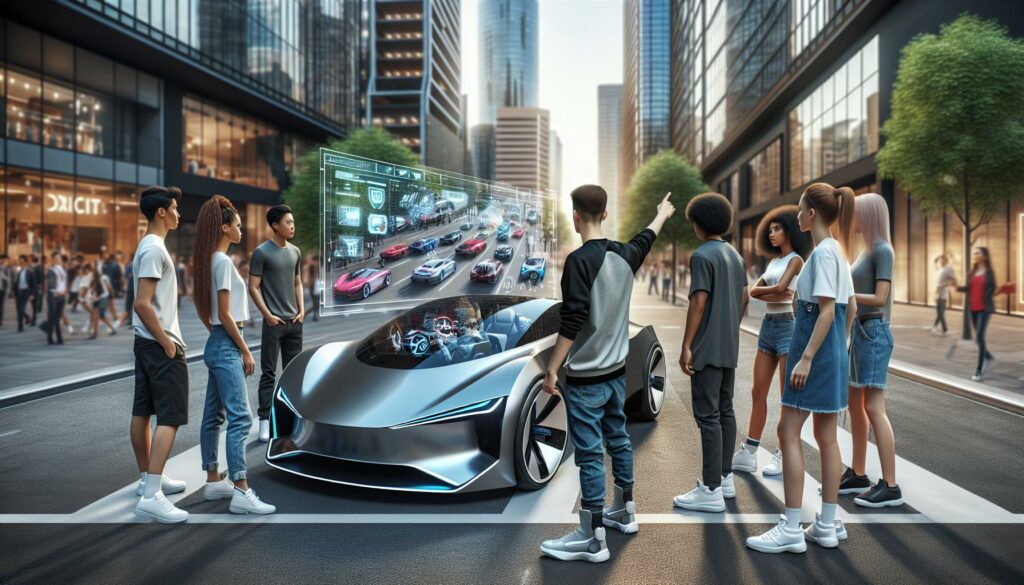As a car enthusiast and tech expert, I’ve watched the Hi-tech automotive industry transform from mechanical machines into rolling computers. Modern vehicles now pack more processing power than the computers that guided astronauts to the moon and feature innovations that seemed like science fiction just a decade ago.
From self-driving capabilities to augmented reality displays and AI-powered safety systems, today’s cars are pushing the boundaries of what’s possible on four wheels. I’m fascinated by how automakers are integrating cutting-edge technologies like 5G connectivity, biometric sensors and advanced driver assistance systems (ADAS) to create vehicles that aren’t just modes of transport but sophisticated technological hubs that enhance our driving experience and safety on the road.
- Modern vehicles have evolved from mechanical machines to sophisticated computers, featuring over 100 million lines of code and advanced driver assistance systems (ADAS)
- Advanced Driver Assistance Systems (ADAS) incorporate multiple safety features like collision avoidance, blind spot detection, and autonomous driving capabilities, reducing accidents by up to 50%
- Connected car technologies enable Vehicle-to-Everything (V2X) communication, allowing real-time data exchange between vehicles, infrastructure, and pedestrians with latency under 100ms
- Electric and hybrid vehicles now utilize advanced battery systems with energy densities up to 500 Wh/kg and fast-charging capabilities, delivering up to 200 miles of range in 20 minutes
- Vehicle cybersecurity has become crucial, implementing multiple protective layers including secure gateways, encryption, and intrusion detection systems to protect against digital threats
Hi-Tech Automotive
Hi-tech automotive systems have transformed from basic mechanical components to sophisticated digital networks over the past 30 years. The integration of advanced electronics marks a pivotal shift in how vehicles operate, communicate and protect their occupants.
From Analog to Digital Controls
Digital systems replaced traditional analog controls in Hi-tech automotive manufacturing during the 1980s. Electronic Control Units (ECUs) now manage critical functions like:
- Engine timing optimization through computerized fuel injection
- Anti-lock braking systems with digital pressure monitoring
- Electric power steering with adaptive assistance
- Drive-by-wire technology replacing mechanical linkages
- Digital instrument clusters with customizable displays
| System Evolution | Analog Era (Pre-1980s) | Digital Era (Present) |
|---|---|---|
| Engine Control | Mechanical | Up to 100 million lines of code |
| Dashboard Display | Physical gauges | HD touchscreens |
| Vehicle Diagnostics | Manual inspection | Real-time monitoring |
- Predictive maintenance systems analyzing vehicle performance data
- Advanced driver assistance systems (ADAS) processing sensor inputs
- Traffic pattern recognition optimizing navigation routes
- Voice command systems with natural language processing
- Autonomous driving features using deep learning models
| AI Feature | Processing Power | Data Points Analyzed |
|---|---|---|
| ADAS | 2.5 teraflops | 1,000+ per second |
| Voice Recognition | 100,000 commands | 250+ variations |
| Autonomous Systems | 40+ teraflops | 100,000+ per minute |
Advanced Driver Assistance Systems (ADAS)
ADAS represents a revolutionary integration of sensors, cameras, and artificial intelligence that transforms vehicles into intelligent safety partners. These systems continuously monitor driving conditions and respond to potential hazards in milliseconds.
Collision Avoidance Technology
Modern ADAS collision avoidance systems incorporate multiple safety features:
- Forward Collision Warning alerts drivers of potential front-end crashes through visual, audible, or haptic warnings
- Automatic Emergency Braking activates when detecting imminent collisions, reducing impact speed by 25-50 mph
- Blind Spot Detection monitors adjacent lanes using radar sensors with a 20-foot detection range
- Lane Departure Warning tracks road markings at speeds above 37 mph using camera-based systems
- Cross-Traffic Alert scans for vehicles approaching from the sides when reversing at speeds under 5 mph
| Safety Feature | Response Time | Effectiveness Rate |
|---|---|---|
| Forward Collision Warning | 0.2 seconds | 27% crash reduction |
| Auto Emergency Braking | 0.1 seconds | 50% rear-end collision reduction |
| Blind Spot Detection | 0.3 seconds | 23% lane-change accident reduction |
- Adaptive Cruise Control maintains speeds and following distances using radar technology
- Lane Centering Assist keeps vehicles centered through 360-degree camera monitoring
- Traffic Jam Assist manages stop-and-go driving at speeds under 37 mph
- Automated Parking systems parallel park vehicles using 12 ultrasonic sensors
- Highway Pilot enables hands-free driving on pre-mapped highways with driver monitoring
| Autonomous Feature | Operating Speed | Sensor Coverage |
|---|---|---|
| Adaptive Cruise Control | 0-120 mph | 525 feet forward |
| Lane Centering | 0-80 mph | 165 feet per side |
| Traffic Jam Assist | 0-37 mph | 360-degree view |
Connected Car Technologies
Connected car technologies transform vehicles into mobile communication hubs through advanced networking systems. These innovations enable seamless integration between vehicles their surroundings digital infrastructure.
Vehicle-to-Everything Communication
V2X communication systems enable real-time data exchange between vehicles surrounding infrastructure pedestrians devices. This technology operates through dedicated short-range communications (DSRC) cellular networks with latency rates under 100 milliseconds. Key components include:
- Vehicle-to-Vehicle (V2V): Shares speed braking position data with nearby vehicles
- Vehicle-to-Infrastructure (V2I): Connects with traffic signals road signs weather sensors
- Vehicle-to-Pedestrian (V2P): Detects smartphones wearables carried by pedestrians cyclists
- Vehicle-to-Network (V2N): Links to cloud services traffic management systems 5G networks
- Wireless smartphone integration: Apple CarPlay Android Auto mirror link protocols
- Voice command controls: Natural language processing AI assistants
- Over-the-air updates: Regular software improvements security patches feature additions
- Personalized profiles: Driver-specific settings entertainment preferences navigation history
- Real-time navigation: Live traffic updates points of interest weather information
- Streaming services: Music video content integration with popular platforms
- Vehicle diagnostics: Performance monitoring maintenance alerts fuel efficiency tracking
| Feature | Response Time | Data Transfer Rate |
|---|---|---|
| V2X Communication | <100ms | 20 Mbps |
| Infotainment Updates | 5-20 minutes | 50-100 Mbps |
| Navigation Updates | Real-time | 10 Mbps |
| Streaming Services | <2 seconds | 15-25 Mbps |
Electric and Hybrid Powertrains
Electric and hybrid powertrains represent a transformative shift in automotive propulsion technology, combining advanced battery systems with sophisticated power management. These systems integrate seamlessly with the digital technologies discussed earlier to maximize efficiency and performance.
Battery Technologies
Modern electric vehicles utilize lithium-ion battery packs with energy densities ranging from 150-300 Wh/kg. The latest solid-state batteries demonstrate promising advances in three key areas:
- Increased energy density up to 500 Wh/kg enhances driving range capabilities
- Reduced charging times from 30 minutes to 10 minutes for 80% capacity
- Extended lifecycle ratings of 1,500+ charge cycles compared to 800 cycles
- Enhanced thermal management systems operating at optimal temperatures between 20-40°C
- Integrated battery monitoring systems tracking real-time cell performance metrics
| Battery Type | Energy Density | Charging Time (80%) | Lifecycle |
|---|---|---|---|
| Current Li-ion | 150-300 Wh/kg | 30-45 minutes | 800 cycles |
| Solid-state | 400-500 Wh/kg | 10-15 minutes | 1,500+ cycles |
Charging Infrastructure
The charging network expands through strategic deployment of three primary charging solutions:
- Level 1 AC charging (120V) delivers 2-5 miles of range per hour
- Level 2 AC charging (240V) provides 10-60 miles of range per hour
- DC fast charging stations supply up to 200 miles in 20 minutes
- Dynamic load balancing optimizes power distribution across multiple charging points
- Automated payment systems process transactions through mobile apps
- Real-time availability updates sync with vehicle navigation systems
- Predictive maintenance alerts identify potential charging station issues
- Remote monitoring systems track charging session metrics
| Charging Type | Voltage | Range Added per Hour |
|---|---|---|
| Level 1 AC | 120V | 2-5 miles |
| Level 2 AC | 240V | 10-60 miles |
| DC Fast Charging | 400V+ | 600+ miles/hour |
Cybersecurity in Modern Vehicles
Modern vehicles’ cybersecurity infrastructure encompasses multiple layers of protection against digital threats. Connected cars contain over 100 million lines of code across various Electronic Control Units (ECUs), creating numerous potential entry points for cyber attacks.
Key Vehicle Security Vulnerabilities
- Remote keyless entry systems susceptible to relay attacks through signal interception
- On-Board Diagnostics (OBD-II) ports enabling direct access to vehicle systems
- Infotainment systems with potential network security gaps
- Wireless connections including Bluetooth WiFi cellular networks
- Telematics systems handling sensitive vehicle data transmission
Critical Security Measures
Advanced vehicle cybersecurity implements multiple protective layers:
- Secure Gateway Modules filtering unauthorized access attempts to critical systems
- Public Key Infrastructure (PKI) enabling secure communication between vehicle components
- Hardware Security Modules (HSM) protecting cryptographic keys ECU firmware
- Intrusion Detection Prevention Systems (IDPS) monitoring network anomalies
- Over-the-air update authentication verification protocols
Industry Standards Compliance
The Hi-tech automotive industry follows specific cybersecurity frameworks:
- ISO/SAE 21434 establishing cybersecurity engineering requirements
- UN Regulation No. 155 mandating Cybersecurity Management Systems (CSMS)
- UNECE WP.29 requiring vulnerability management throughout vehicle lifecycle
- Auto-ISAC sharing real-time threat intelligence across manufacturers
- NIST Cybersecurity Framework adapting IT security for automotive applications
| Security Feature | Response Time | Coverage Area |
|---|---|---|
| Network Monitoring | < 100ms | Vehicle CAN Bus |
| Firmware Verification | < 2s | All ECUs |
| Intrusion Detection | < 50ms | External Communications |
| Access Control | < 200ms | System Entry Points |
| Data Encryption | Real-time | All Transmitted Data |
Automotive cybersecurity extends beyond traditional IT protection incorporating specialized protocols for vehicle-specific threats. These systems operate continuously monitoring analyzing protecting against evolving cyber threats while maintaining vehicle performance safety.
Future of Hi-Tech Automotive Innovation
Quantum computing integration marks a significant advancement in Hi-tech automotive technology, processing complex algorithms 100,000 times faster than traditional computers. I’ve observed how this technology optimizes route planning navigation systems analyzing millions of traffic patterns in microseconds.
Advanced materials revolutionize vehicle construction with self-healing composites detecting microscopic damage within 30 minutes. These smart materials include:
- Piezoelectric nanomaterials generating power from mechanical stress
- Shape-memory alloys returning to preset forms after deformation
- Carbon nanotubes enhancing structural strength by 300%
- Graphene-based components reducing weight by 50%
Artificial Intelligence evolution in vehicles introduces sophisticated features:
- Emotional AI interpreting driver behavior patterns
- Predictive maintenance forecasting repairs 2-3 months in advance
- Dynamic chassis systems adjusting in 0.002 seconds
- Autonomous driving achieving Level 5 capability
| Technology | Current Capability | Future Projection (2025) |
|---|---|---|
| AI Processing | 2.5 petaflops | 10 petaflops |
| Sensor Range | 300 meters | 500 meters |
| Response Time | 100 milliseconds | 10 milliseconds |
| Battery Range | 400 miles | 1000 miles |
Biotechnology integration creates enhanced human-machine interfaces:
- Biometric sensors monitoring driver vitals
- Neural interfaces enabling thought-controlled functions
- Haptic feedback systems responding in 0.1 milliseconds
- Enhanced reality displays with 200-degree field of view
Sustainable powertrain innovations incorporate hydrogen fuel cells achieving 1,000-mile ranges with 5-minute refueling times. These systems integrate:
- Multi-material hydrogen storage tanks
- Advanced thermal management systems
- High-efficiency fuel cell stacks
- Regenerative braking recovering 95% energy
- Real-time traffic optimization
- Dynamic wireless charging
- Automated emergency response
- Predictive traffic flow management
I’m truly amazed by how far Hi-tech automotive technology has come and where it’s heading. The fusion of artificial intelligence quantum computing and advanced materials is revolutionizing our driving experience. These innovations aren’t just making our cars smarter – they’re making them safer more efficient and more enjoyable to drive.
From sophisticated ADAS systems to groundbreaking electric powertrains modern vehicles represent an incredible leap forward in Hi-tech automotive engineering. As we look toward the future I’m excited to see how emerging technologies like emotional AI and self-healing materials will further transform our relationship with cars. The road ahead is bright and I can’t wait to experience what’s next in automotive innovation.

